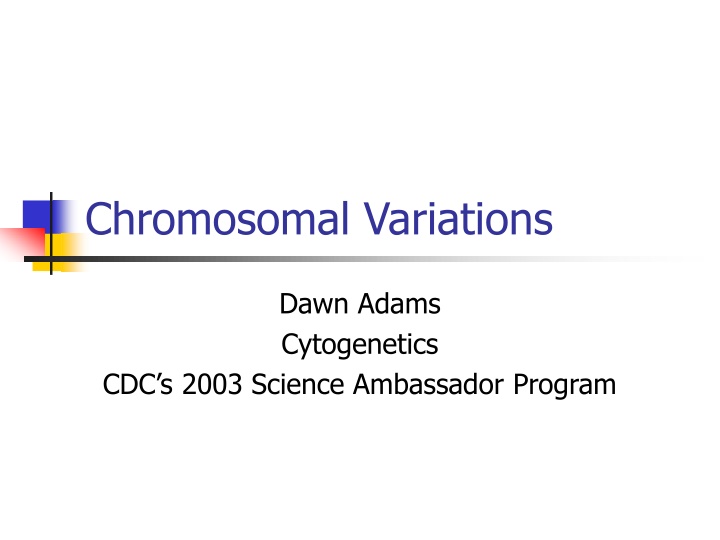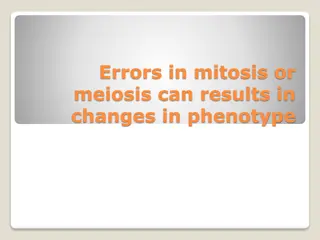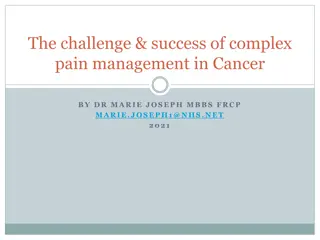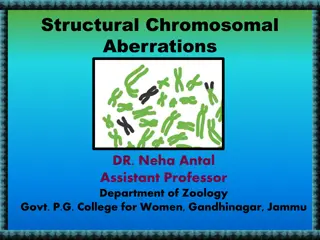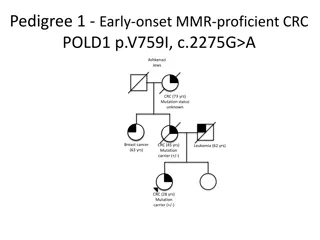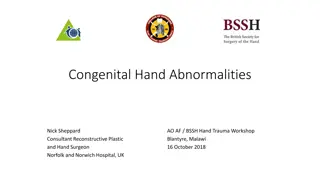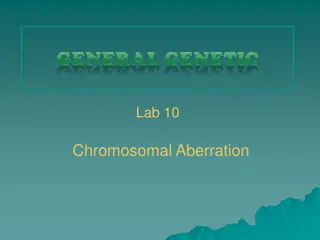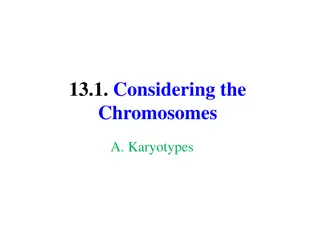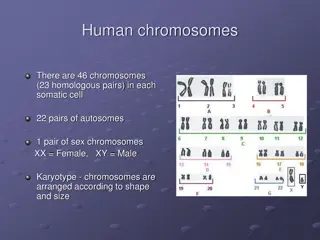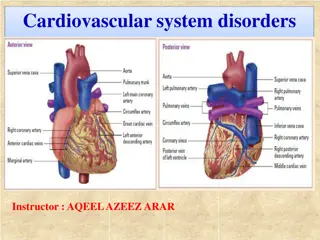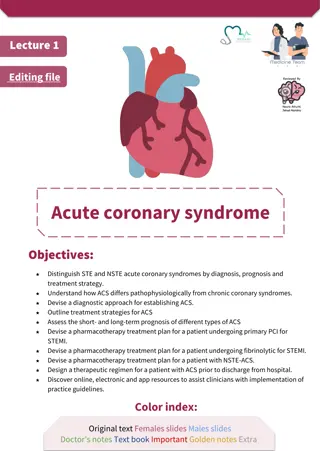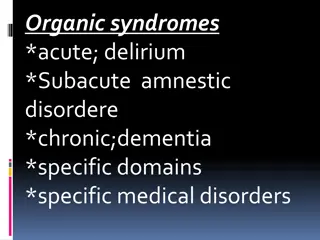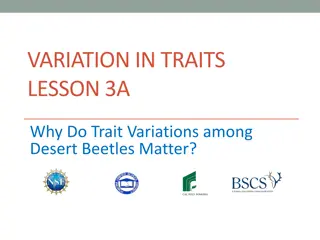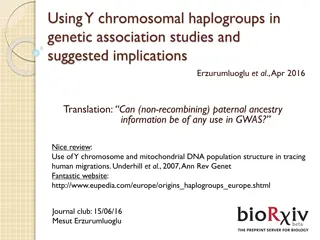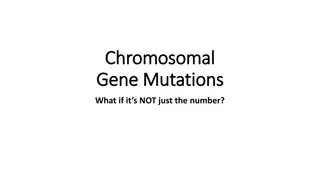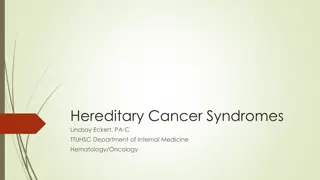Chromosomal Variations and Syndromes Overview
Discussing polyploidy, aneuploidy, and specific syndromes resulting from chromosomal variations, such as Trisomy 13, Trisomy 18, Down Syndrome, Turner Syndrome, Klinefelter Syndrome, and XYY Syndrome. The article explores the different types of polyploidy and aneuploidy, their characteristics, occurrences, and features. It also delves into the implications of chromosomal abnormalities on human health and development.
Download Presentation

Please find below an Image/Link to download the presentation.
The content on the website is provided AS IS for your information and personal use only. It may not be sold, licensed, or shared on other websites without obtaining consent from the author.If you encounter any issues during the download, it is possible that the publisher has removed the file from their server.
You are allowed to download the files provided on this website for personal or commercial use, subject to the condition that they are used lawfully. All files are the property of their respective owners.
The content on the website is provided AS IS for your information and personal use only. It may not be sold, licensed, or shared on other websites without obtaining consent from the author.
E N D
Presentation Transcript
Chromosomal Variations Dawn Adams Cytogenetics CDC s 2003 Science Ambassador Program
Overview I. Chromosomal Variations A. Polyploidy B. Aneuploidy II. Syndromes resulting from Aneuploidy A. Trisomy 13 B. Trisomy 18 C. Down Syndrome D. Turner Syndrome E. Klinefelter Syndrome F. XYY Syndrome
Variations in Chromosomal Number Euploidy the usual number and sets of chromosomes Polyploidy the presence of three or more complete sets of chromosomes Aneuploidy the presence of additional chromosomes or missing individual chromosomes
Types of Polyploidy Triploidy three sets of chromosomes 23 x 3 = 69 Tetraploidy four sets of chromosomes 23 x 4 = 92
Types of Aneuploidy Monosomy one less chromosome (23 x 2) 1 = 45 Trisomy one additional chromosome (23 x 2) + 1 = 47
Aneuploidy When aneuploidy occurs in humans, syndromes can result. Examples include the following: 1. Trisomy 13 2. Trisomy 18 3. Down Syndrome 3. Turner Syndrome 4. Klinefelter Syndrome 5. XYY Syndrome
Trisomy 13 Chromosomal Variation Trisomy 13 (three copies of chromosome 13) Occurrence 1 in 5000
Features of Trisomy 13 Severe developmental delays Head and facial abnormalities Extra fingers and toes Kidney malformations Heart defects Early death
Trisomy 18 Chromosomal Variation Trisomy 18 (three copies of chromosome 18) Occurrence 1 in 5000
Features of Trisomy 18 Severe developmental delays Head and facial malformations Malformations of the hands and feet Skeletal malformations Kidney malformations Structural heart defects Early death
Down Syndrome Chromosomal Variation Trisomy 21 (three copies of chromosome 21) Occurrence 1 in 800-1000
Features of Down Syndrome Low muscle tone Head and facial malformations Abnormalities of the extremities Developmental delays Heart malformations Increased risk of infectious disease Early death
Turner Syndrome Monosomy of sex chromosome (only one X chromosome present) Occurrence 1 in 2500 live female births
Features of Turner Syndrome Short stature Lack of ovarian development Neck abnormalities Skeletal disorders Increased risk of osteoporosis, cardiovascular constriction, diabetes, and kidney and thyroid problems
Klinefelter Syndrome Trisomy of sex chromosome - XXY (An additional X chromosome in males) Occurrence 1 in 500-1000 males
Features of Klinefelter Syndrome Tall Sexually underdeveloped Infertility Sparse facial and body hair Developmental delays Increased risk of autoimmune disorders, breast cancer, osteoporosis, leg ulcers, depression, and dental problems
XYY Syndrome Trisomy of sex chromosome XYY (An additional Y chromosome in males) Occurrence 1 in 1000-2000 men
Features of XYY Syndrome Taller Comparatively low weight relative to stature Larger craniofacial dimensions Severe acne in adolescence Behavior problems Learning disabilities Slightly lower IQ than normal
Conclusions Variations of chromosomal number involving a set of chromosomes (polyploidy) or an individual chromosome (aneuploidy) can occur Aneuploidy results in syndromes with distinct characteristics
References 1. Fairbanks, D. J. and W. R. Anderson. Genetics: The Continuity of Life. Pacific Grove (CA): Brooks/Cole Publishing Company; 1999. 2. National Organization for Rare Disorders. Triploid Syndrome [online]. 2004. [cited 2004 Feb 6]. Available at URL: http://www.rarediseases.org/search/rdbdetail_abstract.html? disname=Triploid%20Syndrome. 3. March of Dimes. Chromosomal Abnormalities [online]. 2004. [cited 2004 Feb 6]. Available from URL: http://www.modimes.org/professionals/681_1209.asp. 4. National Organization for Rare Disorders. Trisomy 13 [online]. 2004. [cited 2004 Feb 6]. Available at URL: http://www.rarediseases.org/ search/rdbdetail_abstract.html?disname=Trisomy%2013%20Syndrome.
References (continued) 5. National Organization for Rare Disorders. Trisomy 18 [online]. 2004. [cited 2004 Feb 6]. Available at URL: http://www.rarediseases.org/ search/rdbdetail_abstract.html?disname=Trisomy%2018%20Syndrome. 6. March of Dimes. Down Sydrome [online]. 2004. [cited 2004 Feb 6]. Available from URL: http://www.marchofdimes.com/professionals/ 681_1214.asp. 7. National Organization for Rare Disorders. Down Syndrome [online]. 2004. [cited 2004 Feb 6]. Available at URL: http://www.rarediseases.org/search/rdbdetail_abstract.html?disname= Down%20Syndrome3. 8. Turner Syndrome Society of the United States. Resources & Research: FAQs [online]. 2003. [cited 2004 Feb 6]. Available from URL: http://www.turner-syndrome-us.org/resource/faq.html.
References (continued 2) 9. National Institutes of Health. Turners Syndrome: Clinical Information [online]. 2004. [cited 2004 Feb 6]. Available from URL: http://turners.nichd.nih.gov/ClinFrintro.html. 10. American Association for Kilnefelter Syndrome Information and Support. Understanding Klinefelter Syndrome [online]. 2004. [cited 2004 Feb 6]. Available from URL: http://www.aaksis.org/bock.cfm. 11. Hambley, Vaughn. What is XXY? [online]. 2004. [cited 2002 Feb 6]. Available from URL: http://47xxy.org/XXY.htm. 12. Texas Department of Health. Birth Defect Risk Factor Series: 47, XYY [online]. 2002. [cited 2004 Feb 6]. Available from URL: http://www.tdh.state.tx.us/tbdmd/risk/risk26-XYY.htm.
References (continued 3) 13. California Center for Health Improvement. XYY Syndrome [online]. 2003. [cited 2004 Feb 6]. Available from URL: http://www.ddhealthinfo.org/ggrc/doc2.asp?ParentID=5199.
